About MOMOA
Information in EnglishAbout the MOGI-HONKE MUSEUM OF ART
Mogi Shichizaemon (1907-2012), the 12th head of the Mogi Honke (main ancestral household line), was interested in art from his youth and collected many works of art over a long period of time. The Mogi-Honke Museum of Art was founded in 2006 to share his art collection with the public so that many people can enjoy these works.
The collection includes approximately 2,900 ukiyo-e prints featuring the series Thirty-six Views of Mount Fuji by Katsushika Hokusai, The Fifty-three Stations of the Tōkaidō Road by Utagawa Hiroshige, as well as ukiyo-e by Kitagawa Utamaro, Tōshūsai Sharaku, Utagawa Kuniyoshi, and others. The collection also covers Japanese paintings by artists such as Yokoyama Taikan, Ogura Yuki and Nakajima Chinami, Western-style paintings by artists including Umehara Ryūzaburō, Wada Eisaku and Kinutani Kōji, sculptures by Takamura Kōun, Hirakushi Denchū and Yabuuchi Satoshi, and ceramic art by Itaya Hazan. The total number of works of art owned by the Museum is approximately 4,300.
In addition to holding several special exhibitions each year, the museum displays around 60 to 70 items as a permanent exhibition. The museum’s architectural design is the work of Hikosaka Yutaka, and the landscape was designed by Ueyama Ryōko, who received the Good Design Award (Architecture and Environment Design Category) in 2002. The Inari shrine of the Mogi Honke is located at the end of the garden.
Mogi Honke
(main ancestral household line)

The ancestry of the Mogi family can be traced back to the Toki family, who resided in Mino province, and also to the Seiwagenji family. The family’s ancestor Maki Genbanokami Yorinori was a samurai, who served Toyotomi Hideyori. Yorinori committed suicide at the fall of Osaka Castle in the summer of 1615, so his wife Shige carried their little son Heizaburō, and escaped from the Castle. They managed to overcome a series of challenges and finally settled in Noda, in Shimousa province. This little child became the first Shichizaemon of the Mogi family. Shige started brewing miso for a living, and later started brewing soy sauce. As time passed, and the number of branch families increased, many of them worked brewing soy sauce. Noda became known as the town of soy sauce, located near Edo (present day Tokyo), which became its largest consumer.
In 1917, six Mogi families, including the Mogi Honke, the Takanashi family, who started brewing soy sauce even before the Mogi family, and the Horikiri family, who had been producing Kantō-style white sweet sake (mirin) in Nagareyama, formed a coalition to establish the Noda Shoyu Kabushiki Kaisha (Noda Soy Sauce Co., Ltd.), which later became Kikkoman Corporation.
Logo of the Mogi-Honke Museum of Art

The kushigata (comb-shape) logo was one of the trademarks of the Mogi Honke. It is said that the kushigata design was taken from the comb-shaped window of the Kyoto Imperial Palace.
When the Noda Shoyu Kabushiki Kaisha was established in 1917, each family sold their soy sauce labeled with their own logos. Later on, the company unified its logo to the most popular trademark of Kikkoman (the logo used by Mogi Saheiji Family, a branch family established during the time of Mogi Shichizaemon the Second).
Upon foundation of the Mogi-Honke Museum of Art, Sano Hiroshi of MOS Design Laboratory Inc. arranged the kushigata logo once used by the Mogi Honke into a modern design. Another symbolic logo of the Museum, “MOMOA” is a design of the abbreviation for the Mogi-Honke Museum of Art. The historic logo dating back to the Edo Period used for soy sauce brewed by the Mogi Honke was revived as a logo of the Mogi-Honke Museum of Art and merged with the Museum’s abbreviation, MOMOA. It is a symbol of the Mogi Honke, whose long-valued philosophy is “Onko Chishin - learning from history.”
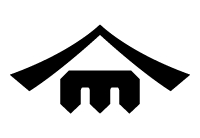
Collection
Ukiyo-e
-
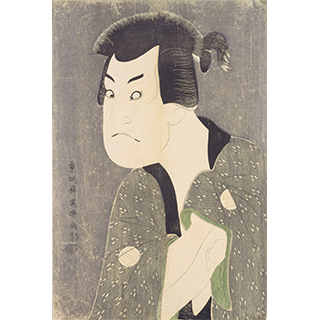 TOSHUSAI Sharaku,The Actor Sakata Hangorō III
TOSHUSAI Sharaku,The Actor Sakata Hangorō III
as Fujikawa Mizuemon -
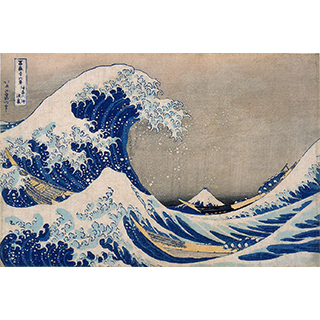 KATSUSHIKA Hokusai,Under the Wave off Kanagawa,
KATSUSHIKA Hokusai,Under the Wave off Kanagawa,
from the series Thirty-six Views of Mount Fuji -
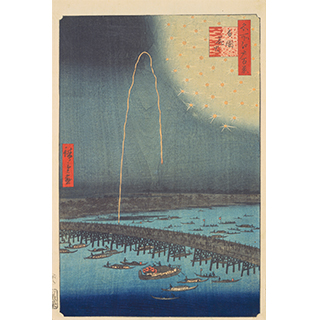 UTAGAWA Hiroshige,Fireworks at Ryogoku,
UTAGAWA Hiroshige,Fireworks at Ryogoku,
from the series One Hundred
Famous Views of Edo
Japanese painting and Western-style painting
-
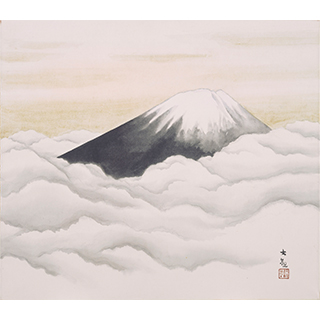 YOKOYAMA Taikan,The Sacred Mountain, Mount Fuji
YOKOYAMA Taikan,The Sacred Mountain, Mount Fuji -
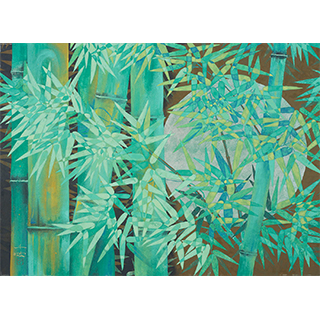 NAKAJIMA Chinami,Bamboos
NAKAJIMA Chinami,Bamboos -
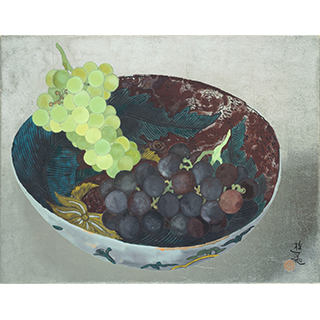 OGURA Yuki,Grapes in an Old Kutani Bowl
OGURA Yuki,Grapes in an Old Kutani Bowl
General Information
- Opening Hours
- 10:00~17:00(admission until 16:00)
- Closed
- Every Monday and Tuesday
(long-term closure period in summer and winter) - Admission
- Adults :700 yen
Persons with certified disabilities and their attendants:600 yen
Free admission for children attending junior high school or younger. - Reservation
- As a general rule guests are kindly requested to book in advance, though you are also welcome without a reservation as long as space is available.
Phone for reservations: +81-4-7120-1489 - Café MOMOA
- The Cafe MOMOA located in the museum offers tea, coffee, sweets and lunch.
Please book for meals by 10:30 on the day of the visit.
For details, please contact the Mogi-Honke Museum of Art. - Address
- 242, Noda, Noda-shi, Chiba-ken, Japan,278-0037
- Tel
- +81-4-7120-1489
- Fax
- +81-4-7120-1012
- Access
-
By Train
8-minute walk from Tobu Urban Park Line Nodashi station
By Car
8km from the Nagareyama or Kashiwa interchanges
The parking lot can accommodate nine vehicles (free of charge)

